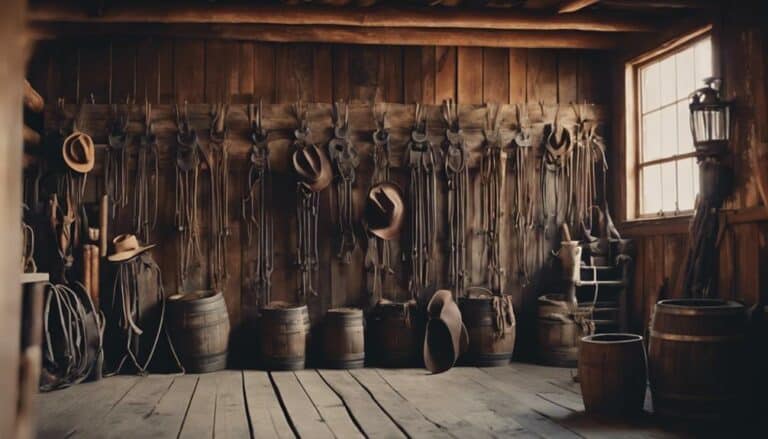Step into the fascinating world of historical ranching equipment. Explore the evolution of cattle brands, from simple symbols to iconic representations. Discover the crucial role of horse-drawn plows and harrows in early ranching practices, shaping agricultural efficiency. Uncover the dedication of ranchers through the maintenance of watering systems, ensuring essential hydration for livestock. Witness how barbed wire revolutionized fencing, allowing ranching operations to expand across frontiers. Admire the intricate saddle-making techniques that provided comfort and style for cowboys on the range. Each relic tells a unique story of ingenuity, hard work, and tradition in the rich tapestry of ranching history.
Key Takeaways
- Cattle brands evolved as iconic symbols of ownership and tradition.
- Horse-drawn plows and harrows revolutionized early ranching practices.
- Watering systems and troughs were vital for livestock hydration.
- Barbed wire innovation transformed land fencing in ranching.
- Saddle-making showcased craftsmanship and comfort for cowboys.
Evolution of Cattle Brands
Throughout the history of ranching, cattle brands have undergone a significant transformation, evolving from practical identification marks to intricate symbols deeply rooted in ranching heritage and ownership.
Early cattle brands were essential for ranchers to distinguish their livestock from others in the vast open ranges of the Old West. These brands, typically simple symbols burned onto livestock hides, played a vital role in preventing cattle theft and disputes over ownership.
To protect their cattle and establish legal ownership, ranchers began registering their unique brands with local authorities. This registration not only helped deter brand theft but also provided a legal basis for resolving ownership conflicts.
Over time, the artistry and complexity of cattle brands increased, with many brands becoming iconic representations of specific ranching families and their longstanding traditions. The evolution of cattle brands showcases not only the practical necessity of livestock identification but also the deep cultural significance and pride associated with ranching heritage.
Horse-Drawn Plows and Harrows
Horse-drawn plows and harrows, essential implements in early ranching, played a pivotal role in breaking and tilling the soil for crop cultivation. These tools, often pulled by teams of horses or oxen, required significant physical effort to operate effectively. The horse-drawn plows featured a sharp blade that cut through the soil, preparing it for planting, while the harrows had teeth designed for smoothing and leveling the ground.
The introduction of horse-drawn plows and harrows marked a significant shift in agricultural practices, increasing efficiency and productivity on ranches. Farmers could now prepare larger areas of land for cultivation in less time, thanks to the power of these animal-drawn implements. The meticulous craftsmanship and attention to detail required in operating these relics of the range reflect the dedication early ranchers had towards their farming endeavors. Horse-drawn plows and harrows stand as symbols of the manual labor and ingenuity that shaped the agricultural landscape of the past.
Watering Systems and Troughs
Watering systems and troughs were indispensable components of historical ranching equipment, ensuring livestock had access to essential water sources for their well-being and productivity. Traditional wooden troughs, often crafted from cedar or pine for their resilience, were a common sight on ranches. These troughs, whether gravity-fed or filled from wells and windmills, provided necessary hydration for cattle, horses, and sheep.
Strategically positioned around pastures and corrals, these troughs made it convenient for ranchers to maintain the hydration of their livestock. Regular maintenance and repairs were important tasks undertaken by ranchers to guarantee a steady water supply for their animals. The placement and upkeep of these watering systems were crucial not only for the health of the livestock but also for the success of the ranching operations.
Ranchers' attention to these details exemplified their dedication to the well-being of their livestock and the efficiency of their historical ranching practices.
Barbed Wire: Fencing Innovation
Barbed wire, a revolutionary fencing innovation of the late 19th century, transformed ranching practices by providing a cost-effective solution for securing vast stretches of land and controlling livestock movement. In the American West, where land was abundant but labor was scarce, the development of barbed wire marked a significant shift from traditional fencing methods like stone walls and wooden fences. The sharp barbs on the wire acted as a deterrent, preventing cattle from breaching boundaries and reducing the need for constant supervision. This newfound efficiency in ranch management allowed for the expansion of ranching operations across the frontier.
The adoption of barbed wire played a pivotal role in the development of the American West, enabling ranchers to increase the size of their herds and secure larger grazing areas. As a result, the landscape of ranching was forever changed, ushering in an era of innovation and progress in livestock management.
Saddle-Making Techniques
The evolution of ranching practices in the American West not only saw the advent of barbed wire for fencing but also witnessed a meticulous artistry in saddle-making techniques that showcased craftsmanship and durability. Saddle-making techniques involve intricate leatherwork, where skilled artisans use tools like awls, needles, and hammers to handcraft each saddle. The traditional process includes cutting, shaping, stitching, and finishing leather to guarantee quality and longevity.
Personalized designs, intricate tooling, and silver accents are often incorporated to reflect individual cowboy styles, adding a touch of personalization to each saddle. The historical significance of saddle-making reflects the craftsmanship and artistry of a bygone era in ranching history, where each saddle was a tribute to the dedication and skill of the saddle maker. By mastering saddle-making techniques, these artisans ensured that cowboys could rely on their saddles for comfort and functionality during long days on the range.
Conclusion
As you gaze upon these relics of the range, you can't help but feel a sense of nostalgia for a bygone era.
The simplicity and ingenuity of the historical ranching equipment remind you of the hard work and dedication of those who came before.
It's ironic how these tools, once essential to survival, are now mere artifacts of the past, serving as a reminder of the changing times and the evolution of ranching practices.

